Pushing and Pulling the door for closing and opening is inevitable without the use of door handles in a traditional and contemporary door design. Door handles can take any form and shape purely for aesthetics or simply for functionality. In this article, we intend to introduce the types of door handles for your home exploring each one.
Types of Door Handles
Door handles come in various styles and designs, each with its unique characteristics and functionality. Here are some common types of door handles:
Pull Handles:
Pull handles are a type of door or cabinet hardware designed to facilitate the opening and closing of doors, drawers, or other items rather than twisting or pressing. As the name suggests, these handles are meant to be pulled to operate the mechanism, providing a means of gripping and pulling to access the desired area. They are commonly used on sliding doors, glass doors, and heavy-duty doors.
They can range from simple, straight bar designs to more ornate, decorative options with intricate detailing. Some common types of pull handles include:
Bar Pulls:
They are straight or slightly curved handles resembling a bar or rod. They are often used in modern or contemporary settings and are available in various lengths. They can take the form of round or square bars. Bar pulls are used on doors, drawers and cabinets.

D-Pulls:
These handles have a shape resembling the letter “D,” with one side attached to the mounting surface and the other forming the gripping area. They are commonly used on heavy doors on both exterior and internal doors.
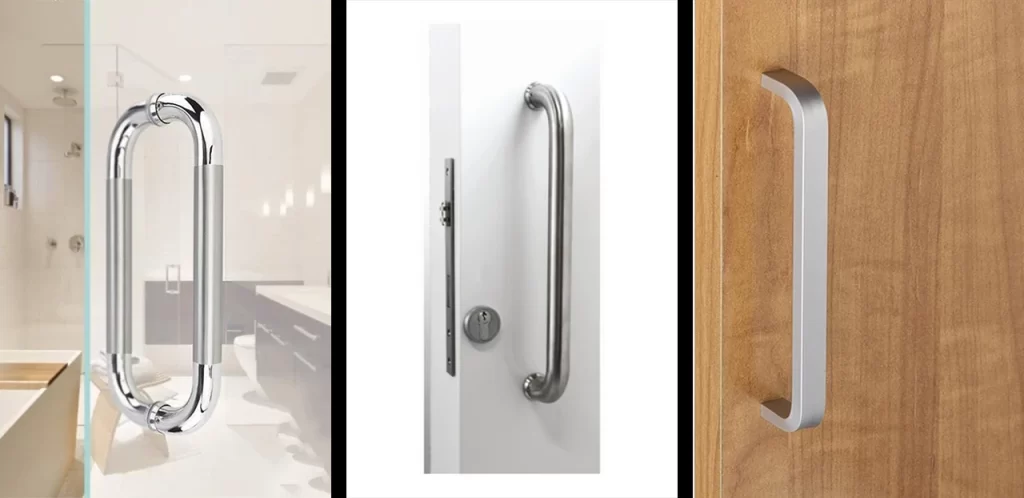
Finger Pulls:
These are small, recessed handles designed to be grasped with the fingers for pulling. They are often used on sliding doors, pocket doors, or drawers with a desired flush or minimalist appearance.
Finger pulls come in a variety of designs and styles to meet different preferences. In some cases, they are curved directly onto the timber itself, forming a convenient finger handle.

Appliance Pulls:
These are large and sturdy pull handles typically used on refrigerators, dishwashers, and other large appliances. They are designed to withstand heavy use and provide a secure grip.
Bow Door Handles:
A bow handle, also known as a bow pull or bow-shaped handle, is a type of cabinet or drawer handle characterized by its curved or arched shape resembling a bow or an arc. These handles typically feature a rounded or cylindrical grip section connected to two mounting points on either end, creating a gentle curve between them. Bow handles come in various sizes, ranging from small to large, to accommodate different cabinet and drawer dimensions.
Bow handles are of four types as per Indian Standard code 208: 1996 as follows:
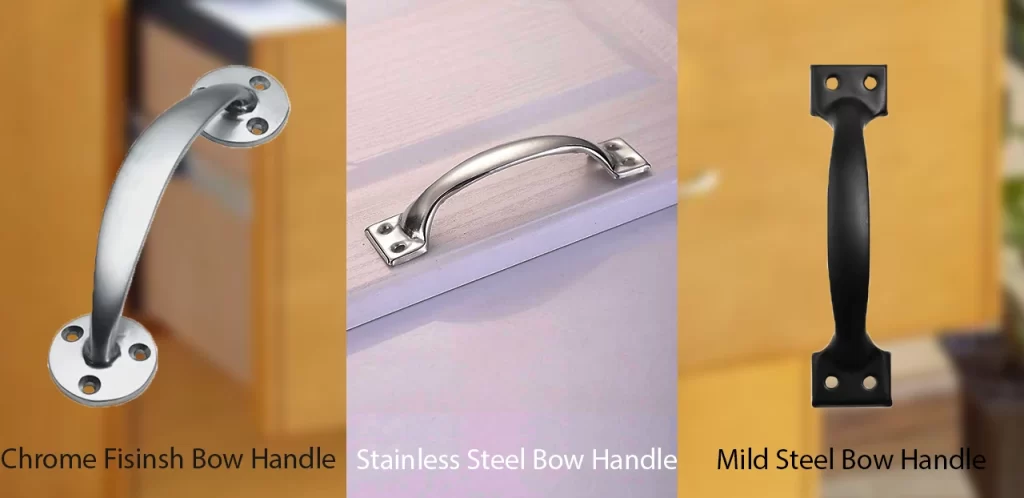
Knob Handles:
Sometimes referred to simply as “knobs,” door knobs typically come in round or oval shapes and may or may not include a latch mechanism. When equipped with a latch, they are twisted to engage or disengage the latch, commonly seen on exterior main doors for home security. Those lacking a latch are widely employed on interior doors such as wardrobes, cabinets, and other types of furniture that require opening and closing.
They are available in all types of materials with a bright finish or matt finish. Metal door knobs, such as brass, stainless steel, or bronze, are popular for their durability and classic appearance. Wood door knobs offer a warm and natural look, often used in rustic or traditional settings. Whereas ceramic door knobs can add a touch of elegance and are available in various colours and designs.
Glass door knobs can create a sleek and modern look, especially when paired with metal hardware. Composite materials offer a mix of durability and versatility, often mimicking the appearance of other materials while providing additional benefits such as resistance to moisture or scratches.
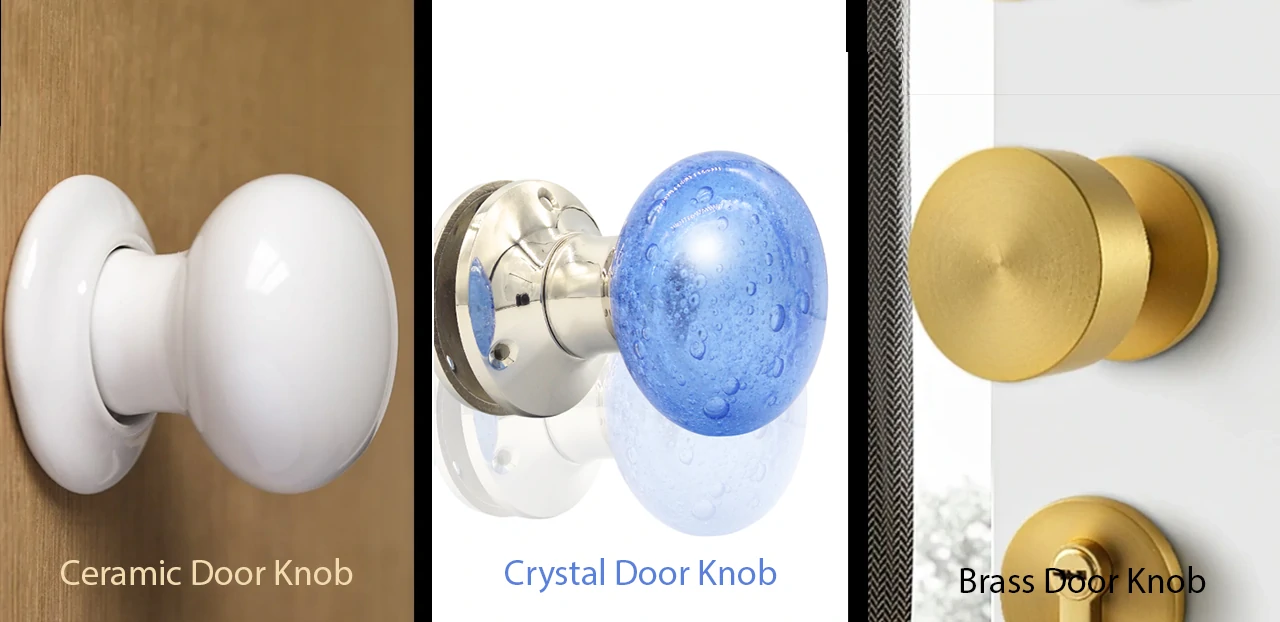
Lever Handles:
Unlike knobs, which require a twisting motion, door levers are operated by pushing down or pressing upwards on a lever mechanism. Door levers are fixed perpendicular to the door stile. This design offers benefits to individuals facing mobility challenges or having limited hand strength, as it demands less manual dexterity to use.
They are commonly used on both interior and exterior doors, especially in commercial buildings and homes with accessibility considerations. They are often used in homes, offices, hotels, and public buildings due to their ease of use and accessibility features.
Door levers come in a variety of materials, including metal, wood, ceramic, and composite materials. They also come in various finishes, such as polished chrome, satin nickel, antique brass, and more, allowing them to complement different interior design aesthetics.
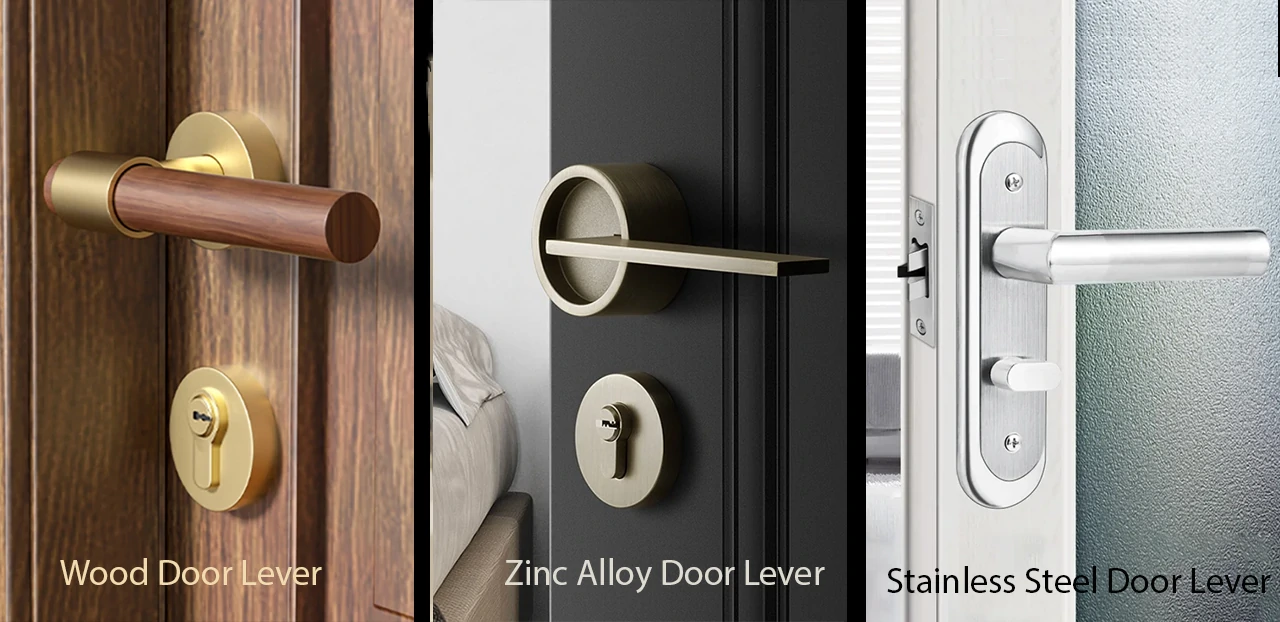
Also, read: Types of Doors used in Building Construction: 11 Types
Thumb Latch Handles:
These handles often feature a lever or paddle that can be pressed down or pushed upward using the thumb, activating the latch mechanism to open or close the door. This design is particularly convenient for quick and easy access. They are suitable for gates, and doors where privacy is not a concern, such as pantry and showcase doors.
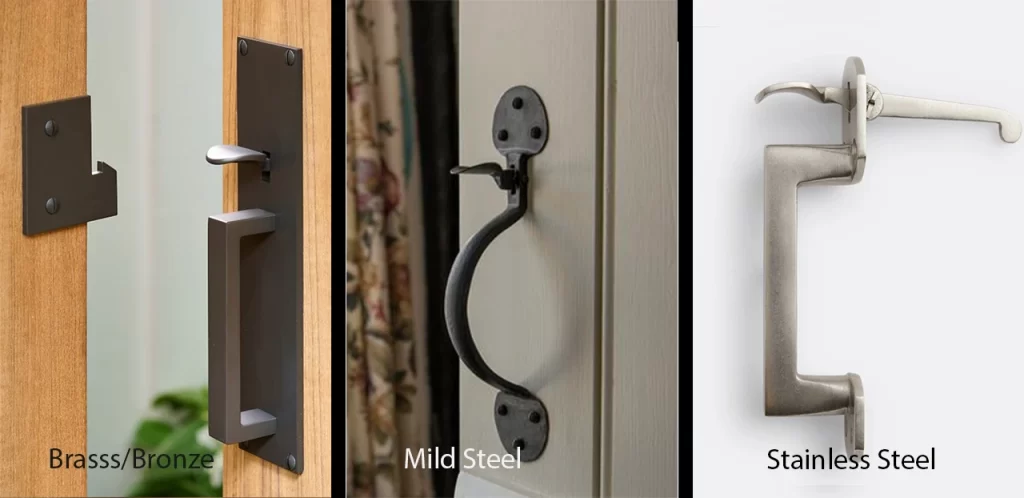
Handle Sets:
Sets of door handles that include a handle for the exterior side of the door and a separate handle or knob for the interior side. They are often used on entry doors and come in various styles and finishes.
Mortise latch
Mortise latches are the type of door latch mechanism that is installed within a rectangular cavity, or mortise cut into the edge of a door. It consists of a handle mounted on a rectangular plate that houses the latch mechanism within the door. Mortise latch handles typically include a lever or knob for operating the latch mechanism. When the lever or knob is turned or pressed, it engages or disengages the latch, allowing the door to be opened or closed.
One of the advantages of mortise latch handles is their durability and reliability. Additionally, the flush-mount design contributes to a sleek and attractive looks that complements various interior styles.
Also, read: Types of Door Frames: Size, Materials & Specification
Materials for Door Handles
Door handles can be crafted from various materials, each offering its own unique aesthetic appeal, durability, and functionality. Here are some common materials used for door handles:
- Metal:
- Stainless Steel: Known for its durability, resistance to corrosion, and modern appearance, stainless steel handles are popular for both interior and exterior doors.
- Brass: Brass handles offer a classic and elegant look, and they can come in polished, satin, or antique finishes.
- Aluminium: Lightweight and corrosion-resistant, aluminium handles are often used in contemporary and minimalist designs
- Bronze: Bronze handles provide a rich and timeless look, with options for oil-rubbed, polished, or aged finishes.
- Wood:
- Wooden Handles: Wooden handles add warmth and natural beauty to doors. They can be made from various types of wood, such as oak, maple, walnut, and cherry, and can be stained or painted to match different decor styles.
- Composite Wood: Engineered wood products, such as MDF (medium-density fiberboard) or plywood, can also be used to create affordable and durable door handles.
- Glass:
- Glass Handles: Glass handles offer a sleek and modern look, often featuring decorative patterns or colours. They are commonly used on glass doors or doors with glass panels.
- Crystal: Crystal handles add a touch of luxury and elegance to doors, with their sparkling appearance and ability to refract light.
- Plastic:
- Acrylic: Acrylic handles are lightweight, affordable, and available in a variety of colours and styles. They are often used in contemporary and children’s rooms.
- Nylon: Nylon handles are durable, resistant to corrosion, and suitable for outdoor applications. They are commonly used in industrial and commercial settings.
- Ceramic:
- Porcelain: Porcelain handles offer a vintage and decorative look, with options for intricate designs and patterns. They are commonly used in traditional and farmhouse-style interiors.
- Composite Materials:
- Fiberglass: Fiberglass handles are lightweight, durable, and resistant to corrosion, making them suitable for exterior doors.
- Composite Resins: Composite resin handles can mimic the appearance of natural materials like wood or stone while offering enhanced durability and weather resistance.
Also, read: Types of Flush Doors: 4-Types in General
References:
- Bureau of Indian Standards. (1996). IS 208:1998. Door Handles- Specification. New Delhi, 110002
- Punima, Dr. B. C., Jain, Er. A. K., & Jain, Dr. A. K. (2023). Building Construction (12th ed.). Luxmi Publication (P) Limited. https://www.laxmipublications.com/servlet/lpgetbiblio?bno=000200&pageName=Keywords
- Dale, T. (2023, October 19). 10 types of door handles homeowners should know. The Spruce. https://www.thespruce.com/types-of-door-handles-7565664
![]()







